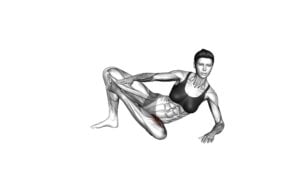Shuffle Diagonal Reaches (female) – Video Exercise Guide & Tips

Looking to amp up your workout routine? Try shuffle diagonal reaches! This video exercise guide and tips will show you how to properly perform this move, avoid common mistakes, and challenge yourself with variations.
Watch This Exercise Video
Whether you're a beginner or a fitness pro, incorporating shuffle diagonal reaches into your routine will help improve your coordination, strength, and overall fitness level.
Get ready to step up your game and feel the burn with this engaging and effective exercise.
Key Takeaways
- Shuffle diagonal reaches engage core muscles and improve balance and coordination.
- There are different variations of shuffle diagonal reaches that target multiple muscle groups and provide diverse muscle activation.
- Proper form is important in shuffle diagonal reaches, including maintaining a stable core, engaging abdominal muscles, and performing controlled and deliberate movements.
- Controlling speed during shuffle diagonal reaches is crucial to prevent injuries and maintain proper technique.
Benefits of Shuffle Diagonal Reaches
Experience the benefits of Shuffle Diagonal Reaches as you engage your core and improve your balance and coordination. Shuffle Diagonal Reaches are a dynamic exercise that target multiple muscle groups while challenging your stability and agility. By incorporating different variations of this exercise into your workout routine, you can maximize its effectiveness and achieve optimal results.
One variation of Shuffle Diagonal Reaches is the forward reach. Begin by standing with your feet hip-width apart and knees slightly bent. Shuffle diagonally to the right, reaching your left hand towards the outside of your right foot. Return to the starting position and repeat on the other side. This variation targets your obliques, glutes, and quadriceps.
Another variation is the rotational reach. Start in the same position as the forward reach, but this time, as you shuffle diagonally, twist your torso and reach your opposite hand towards the outside of your foot. This variation engages your core, shoulders, and upper back.
To improve your balance and coordination during Shuffle Diagonal Reaches, focus on maintaining a stable core and keeping your gaze forward. Engage your abdominal muscles to stabilize your body and prevent excessive swaying or leaning. Additionally, ensure that your movements are controlled and deliberate, rather than rushed or jerky. By practicing proper form and incorporating these tips, you'll enhance the benefits of Shuffle Diagonal Reaches and optimize your workout.
How to Properly Perform Shuffle Diagonal Reaches
To properly perform Shuffle Diagonal Reaches, there are a few key points to keep in mind.
First, focus on maintaining balance and coordination throughout the exercise.
Avoid common mistakes such as rushing the movement or losing form.
Lastly, remember the benefits of this exercise, which include improved agility and core strength.
Balance and Coordination Tips
Achieve better balance and coordination by practicing proper form during Shuffle Diagonal Reaches. To improve your balance and coordination, consider incorporating the following tips:
- Engage in balance exercises: Incorporate exercises like standing on one leg or using a balance board to improve your stability and proprioception.
- Include coordination drills: Add exercises that focus on coordination, like ladder drills or agility ladder exercises, to enhance your coordination skills.
- Focus on core strength: Strengthening your core muscles can help improve your balance and stability during Shuffle Diagonal Reaches.
By following these tips, you can enhance your balance and coordination while performing Shuffle Diagonal Reaches.
Now, let's move on to the next section to learn about common mistakes to avoid when performing this exercise.
Common Mistakes to Avoid
To properly perform Shuffle Diagonal Reaches, avoid the common mistake of shifting your weight too far forward or backward. This mistake can throw off your balance and compromise the effectiveness of the exercise. Instead, focus on maintaining a stable and centered position throughout the movement.
Another common mistake to avoid is rushing through the exercise. Take your time and perform each rep with control and precision. This will ensure that you're engaging the right muscles and maximizing the benefits of the exercise.
If you find the exercise too challenging, you can modify it by reducing the range of motion or slowing down the tempo. Remember, it's better to perform the exercise correctly with modifications than to risk injury by pushing yourself too hard.
Benefits of This Exercise
You can experience significant improvements in core strength, balance, and coordination by incorporating Shuffle Diagonal Reaches into your workout routine. This exercise targets multiple muscle groups and provides numerous benefits when performed with proper technique and muscle engagement.
Here are some key benefits of this exercise:
- Core strength: Shuffle Diagonal Reaches engage the muscles in your core, including the abdominals and obliques, helping to strengthen and stabilize your midsection.
- Balance: By moving laterally and diagonally while reaching, this exercise challenges your balance and proprioception, improving your overall stability.
- Coordination: The combination of shuffling and reaching movements in Shuffle Diagonal Reaches enhances your coordination and motor skills, as you have to coordinate your lower body and upper body movements simultaneously.
Incorporating Shuffle Diagonal Reaches into your routine can have a positive impact on your fitness goals, enhancing your core strength, balance, and coordination.
Common Mistakes to Avoid
To ensure proper form during Shuffle Diagonal Reaches, there are a few common mistakes you should avoid.
First, focus on form correction tips such as keeping your core engaged and maintaining a neutral spine.
Additionally, make sure to maintain proper body alignment throughout the exercise, avoiding any excessive twisting or bending.
Lastly, be mindful of not rushing the movement and prioritize control over speed to maximize the effectiveness of the exercise.
Form Correction Tips
Avoid falling into the common mistake of slouching or hunching your shoulders during shuffle diagonal reaches. Maintaining proper form is essential to prevent injury and maximize the effectiveness of this exercise.
Here are some form correction tips to keep in mind:
- Engage your core: Remember to tighten your abdominal muscles throughout the movement to stabilize your body and maintain proper alignment.
- Keep your back straight: Avoid rounding your back or arching it excessively. Maintain a neutral spine position to protect your lower back.
- Relax your neck and shoulders: Avoid tensing up your shoulders or bringing them up towards your ears. Keep them relaxed and down throughout the exercise.
Modifications for beginners:
- Perform the exercise at a slower pace to focus on maintaining proper form.
- Use lighter weights or no weights at all until you feel comfortable with the movement.
- Start with a smaller range of motion and gradually increase as you build strength and flexibility.
Proper Body Alignment
Maintaining proper body alignment is crucial to avoid common mistakes during the shuffle diagonal reaches exercise.
To achieve proper form, start by standing with your feet hip-width apart and your knees slightly bent. Engage your core muscles by pulling your belly button towards your spine. Keep your shoulders relaxed and down, away from your ears.
Throughout the exercise, focus on keeping your spine neutral and avoiding any excessive arching or rounding. This will help to ensure proper muscle activation and prevent strain on your back.
Remember to breathe deeply and exhale as you reach diagonally across your body.
Avoiding Excessive Speed
To maintain proper form and avoid common mistakes during the shuffle diagonal reaches exercise, it's important to focus on controlling your speed and not rushing through the movements. By preventing excessive speed, you can reduce the risk of injuries and ensure that you're maintaining control throughout the exercise.
Here are some key tips to help you avoid excessive speed:
- Start with a slower pace: Begin the exercise at a pace that allows you to perform the movements correctly and with control.
- Focus on technique: Concentrate on executing each shuffle and reach with precision and proper form, rather than trying to move quickly.
- Gradually increase speed: As you become more comfortable and confident, you can gradually increase your speed while still maintaining control.
Variations to Challenge Yourself
Challenge yourself with these variations of the Shuffle Diagonal Reaches exercise. If you're an advanced practitioner looking to take your workout to the next level, these variations will add intensity and complexity to your routine.
One variation you can try is adding resistance bands to the exercise. Attach the bands to a sturdy anchor point and hold the handles in your hands. As you perform the shuffle diagonal reaches, the resistance from the bands will engage your muscles even more, making the exercise more challenging.
Another option is to incorporate weights into the exercise. Hold a dumbbell or kettlebell in each hand as you perform the shuffle diagonal reaches. The added weight will require more strength and stability, providing an extra challenge for your muscles.
If you have access to a BOSU ball or a balance board, you can also try performing the shuffle diagonal reaches on an unstable surface. This will require more core activation and improve your balance and coordination.
Remember to choose variations that are appropriate for your fitness level and always prioritize proper form and technique. These variations will help you push your limits and continue progressing in your fitness journey.
Tips for Incorporating Shuffle Diagonal Reaches Into Your Workout Routine
To maximize the effectiveness of your workout routine, incorporate Shuffle Diagonal Reaches as a dynamic and challenging exercise. This exercise not only targets multiple muscle groups but also improves coordination and agility.
Here are some tips for incorporating Shuffle Diagonal Reaches into your workout routine:
- Start with a warm-up: Before performing any exercise, it's important to warm up your body to prevent injuries. Spend a few minutes doing light cardio exercises like jumping jacks or jogging in place.
- Include them in a HIIT workout: High-intensity interval training (HIIT) is a great way to burn calories and improve cardiovascular fitness. Incorporate Shuffle Diagonal Reaches into your HIIT routine by performing them for a set amount of time, followed by a short rest period. Repeat this cycle for multiple rounds.
- Modify for different fitness levels: If you're a beginner, you can start by performing Shuffle Diagonal Reaches at a slower pace or reducing the range of motion. As you progress, gradually increase the speed and intensity of the exercise to challenge yourself.
- Focus on proper form: Pay attention to your body alignment and engage your core throughout the exercise. Keep your chest lifted, shoulders relaxed, and avoid rounding your back.
- Add variety: To keep your workout routine interesting, try incorporating different variations of Shuffle Diagonal Reaches. You can add weights or resistance bands to increase the intensity or perform them on an unstable surface like a balance board or BOSU ball.
Safety Precautions and Modifications for Beginners
For beginners, it's important to take certain safety precautions and make modifications when incorporating Shuffle Diagonal Reaches into your workout routine. These exercises can be intense and may require some adjustments to ensure your safety and prevent potential injuries.
First and foremost, it's crucial to listen to your body and start with lighter weights or no weights at all. This will help you build up strength and avoid straining your muscles. Additionally, focus on maintaining proper form throughout the exercise. Keep your back straight, engage your core, and avoid any jerky or sudden movements.
To further ensure your safety, consider performing the Shuffle Diagonal Reaches on a soft surface or using a mat to cushion your movements. This can help reduce the impact on your joints and minimize the risk of any potential injuries.
As a beginner, you may also want to start with a shorter duration or fewer repetitions. Gradually increase the intensity and duration as you become more comfortable and confident with the exercise. Remember, it's better to start slow and progress gradually than to push yourself too hard and risk injury.
Frequently Asked Questions
What Are Some Alternative Exercises That Can Provide Similar Benefits to Shuffle Diagonal Reaches?
If you're looking for alternative exercises that offer similar benefits to shuffle diagonal reaches, there are a few options to consider.
To strengthen your core, you could try exercises like planks, Russian twists, or bicycle crunches.
For cardiovascular benefits, activities like running, cycling, or jumping rope can get your heart rate up.
Remember to always consult a professional before starting any new exercise routine.
How Many Calories Can Be Burned by Performing Shuffle Diagonal Reaches?
Shuffle diagonal reaches can be a great addition to your HIIT workout routine. They provide numerous benefits, including cardiovascular endurance, improved agility, and increased calorie burn. While the exact number of calories burned depends on factors like weight and intensity, shuffle diagonal reaches can help you achieve your fitness goals.
To modify the exercise for beginners, you can start with slower movements and gradually increase the speed and range of motion as you build strength and confidence.
Can Shuffle Diagonal Reaches Help Improve Flexibility?
Incorporating shuffle diagonal reaches into your daily workout routine can provide several benefits.
One of these benefits is an improvement in flexibility. By performing this exercise, you can stretch and strengthen your muscles, which can lead to increased range of motion and flexibility.
To ensure you're performing shuffle diagonal reaches correctly, remember to engage your core, maintain proper posture, and use controlled movements.
Following these tips will help you optimize the effectiveness of this exercise.
Is It Necessary to Warm up Before Performing Shuffle Diagonal Reaches?
To avoid injury and get the maximum benefit from your workout, it's important to warm up before performing shuffle diagonal reaches.
Warm up exercises increase blood flow to your muscles and prepare your body for the movements ahead. By raising your heart rate and stretching your muscles, you reduce the risk of strains or pulls.
Take a few minutes to warm up by doing light cardio exercises and dynamic stretches, ensuring your body is ready for shuffle diagonal reaches.
Are There Any Specific Muscle Groups That Shuffle Diagonal Reaches Target?
When performing shuffle diagonal reaches, you engage multiple muscle groups. These include the muscles in your lower body, such as your quads, hamstrings, and glutes, as you perform crossover lunges.
Additionally, shuffle diagonal reaches also target your lateral core strength, working the muscles along your sides and obliques.
Conclusion
Shuffle diagonal reaches are a beneficial exercise for women that can be easily incorporated into a workout routine. By engaging multiple muscle groups and promoting balance and coordination, this exercise helps improve overall strength and fitness.
It's important to perform shuffle diagonal reaches correctly to avoid common mistakes and maximize their effectiveness. Beginners should take necessary safety precautions and consider modifications as needed.
With variations available, this exercise can be adjusted to challenge individuals at different fitness levels.

Author
Years ago, the spark of my life’s passion ignited in my mind the moment I stepped into the local gym for the first time. The inaugural bead of perspiration, the initial endeavor, the very first surge of endorphins, and a sense of pride that washed over me post-workout marked the beginning of my deep-seated interest in strength sports, fitness, and sports nutrition. This very curiosity blossomed rapidly into a profound fascination, propelling me to earn a Master’s degree in Physical Education from the Academy of Physical Education in Krakow, followed by a Sports Manager diploma from the Jagiellonian University. My journey of growth led me to gain more specialized qualifications, such as being a certified personal trainer with a focus on sports dietetics, a lifeguard, and an instructor for wellness and corrective gymnastics. Theoretical knowledge paired seamlessly with practical experience, reinforcing my belief that the transformation of individuals under my guidance was also a reflection of my personal growth. This belief holds true even today. Each day, I strive to push the boundaries and explore new realms. These realms gently elevate me to greater heights. The unique combination of passion for my field and the continuous quest for growth fuels my drive to break new ground.







